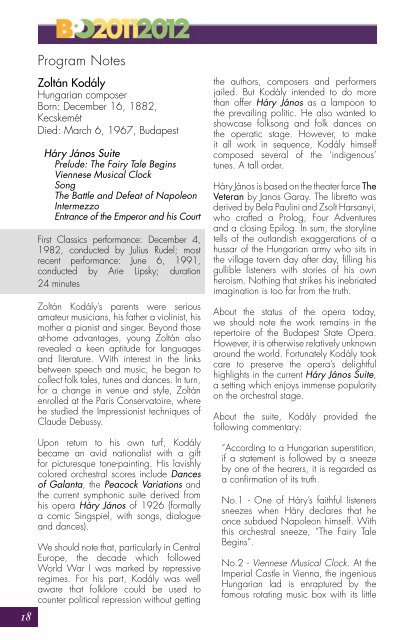Table of Contents - The Buffalo Philharmonic Orchestra
Table of Contents - The Buffalo Philharmonic Orchestra
Table of Contents - The Buffalo Philharmonic Orchestra
Create successful ePaper yourself
Turn your PDF publications into a flip-book with our unique Google optimized e-Paper software.
18<br />
Program Notes<br />
Zoltán Kodály<br />
Hungarian composer<br />
Born: December 16, 1882,<br />
Kecskemét<br />
Died: March 6, 1967, Budapest<br />
Háry János Suite<br />
Prelude: <strong>The</strong> Fairy Tale Begins<br />
Viennese Musical Clock<br />
Song<br />
<strong>The</strong> Battle and Defeat <strong>of</strong> Napoleon<br />
Intermezzo<br />
Entrance <strong>of</strong> the Emperor and his Court<br />
First Classics performance: December 4,<br />
1982, conducted by Julius Rudel; most<br />
recent performance: June 6, 1991,<br />
conducted by Arie Lipsky; duration<br />
24 minutes<br />
Zoltán Kodály’s parents were serious<br />
amateur musicians, his father a violinist, his<br />
mother a pianist and singer. Beyond those<br />
at-home advantages, young Zoltán also<br />
revealed a keen aptitude for languages<br />
and literature. With interest in the links<br />
between speech and music, he began to<br />
collect folk tales, tunes and dances. In turn,<br />
for a change in venue and style, Zoltán<br />
enrolled at the Paris Conservatoire, where<br />
he studied the Impressionist techniques <strong>of</strong><br />
Claude Debussy.<br />
Upon return to his own turf, Kodály<br />
became an avid nationalist with a gift<br />
for picturesque tone-painting. His lavishly<br />
colored orchestral scores include Dances<br />
<strong>of</strong> Galanta, the Peacock Variations and<br />
the current symphonic suite derived from<br />
his opera Háry János <strong>of</strong> 1926 (formally<br />
a comic Singspiel, with songs, dialogue<br />
and dances).<br />
We should note that, particularly in Central<br />
Europe, the decade which followed<br />
World War I was marked by repressive<br />
regimes. For his part, Kodály was well<br />
aware that folklore could be used to<br />
counter political repression without getting<br />
the authors, composers and performers<br />
jailed. But Kodály intended to do more<br />
than <strong>of</strong>fer Háry János as a lampoon to<br />
the prevailing politic. He also wanted to<br />
showcase folksong and folk dances on<br />
the operatic stage. However, to make<br />
it all work in sequence, Kodály himself<br />
composed several <strong>of</strong> the ‘indigenous’<br />
tunes. A tall order.<br />
Háry János is based on the theater farce <strong>The</strong><br />
Veteran by Janos Garay. <strong>The</strong> libretto was<br />
derived by Bela Paulini and Zsolt Harsanyi,<br />
who crafted a Prolog, Four Adventures<br />
and a closing Epilog. In sum, the storyline<br />
tells <strong>of</strong> the outlandish exaggerations <strong>of</strong> a<br />
hussar <strong>of</strong> the Hungarian army who sits in<br />
the village tavern day after day, filling his<br />
gullible listeners with stories <strong>of</strong> his own<br />
heroism. Nothing that strikes his inebriated<br />
imagination is too far from the truth.<br />
About the status <strong>of</strong> the opera today,<br />
we should note the work remains in the<br />
repertoire <strong>of</strong> the Budapest State Opera.<br />
However, it is otherwise relatively unknown<br />
around the world. Fortunately Kodály took<br />
care to preserve the opera’s delightful<br />
highlights in the current Háry János Suite,<br />
a setting which enjoys immense popularity<br />
on the orchestral stage.<br />
About the suite, Kodály provided the<br />
following commentary:<br />
“According to a Hungarian superstition,<br />
if a statement is followed by a sneeze<br />
by one <strong>of</strong> the hearers, it is regarded as<br />
a confirmation <strong>of</strong> its truth.<br />
No.1 - One <strong>of</strong> Háry’s faithful listeners<br />
sneezes when Háry declares that he<br />
once subdued Napoleon himself. With<br />
this orchestral sneeze, “<strong>The</strong> Fairy Tale<br />
Begins”.<br />
No.2 - Viennese Musical Clock. At the<br />
Imperial Castle in Vienna, the ingenious<br />
Hungarian lad is enraptured by the<br />
famous rotating music box with its little






